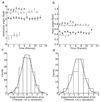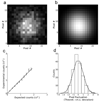Optimized localization analysis for single-molecule tracking and super-resolution microscopy
- PMID: 20364147
- PMCID: PMC3127582
- DOI: 10.1038/nmeth.1447
Optimized localization analysis for single-molecule tracking and super-resolution microscopy
Abstract
We optimally localized isolated fluorescent beads and molecules imaged as diffraction-limited spots, determined the orientation of molecules and present reliable formulas for the precision of various localization methods. Both theory and experimental data showed that unweighted least-squares fitting of a Gaussian squanders one-third of the available information, a popular formula for its precision exaggerates beyond Fisher's information limit, and weighted least-squares may do worse, whereas maximum-likelihood fitting is practically optimal.
Figures




Comment in
-
The economy of photons.Nat Methods. 2010 May;7(5):357-9. doi: 10.1038/nmeth0510-357. Nat Methods. 2010. PMID: 20431547 No abstract available.
References
Publication types
MeSH terms
Grants and funding
LinkOut - more resources
Full Text Sources
Other Literature Sources

